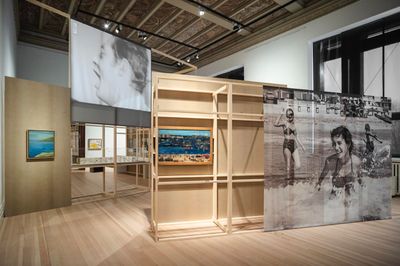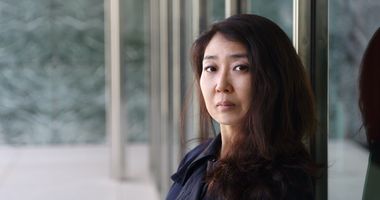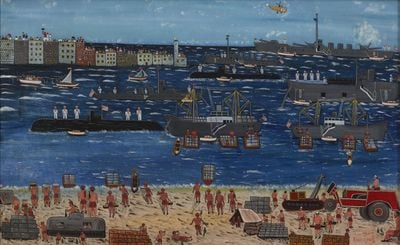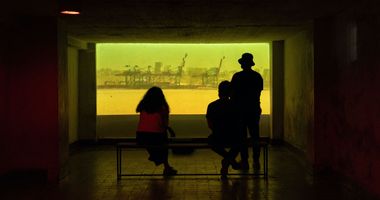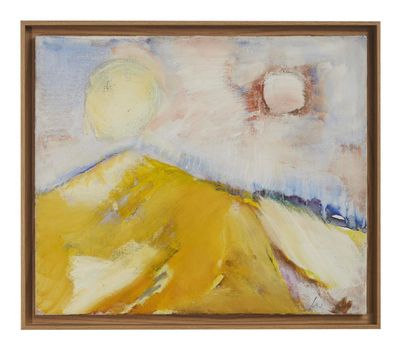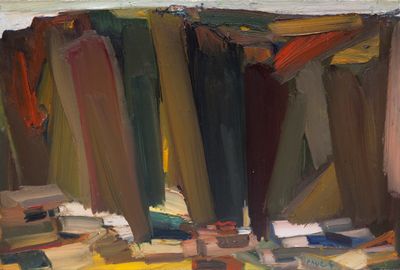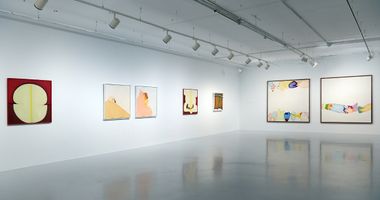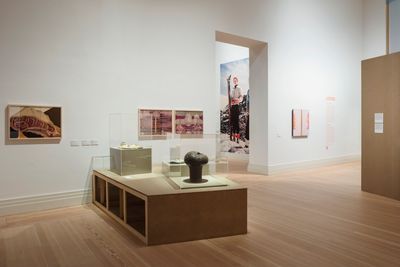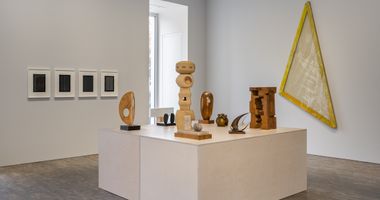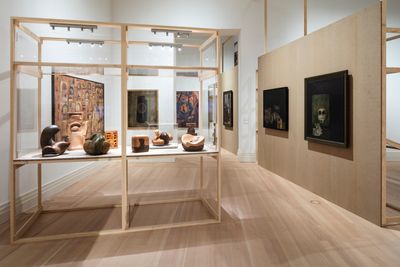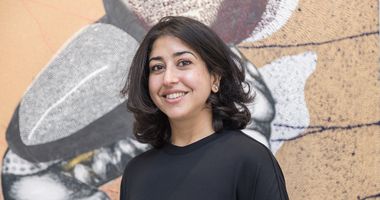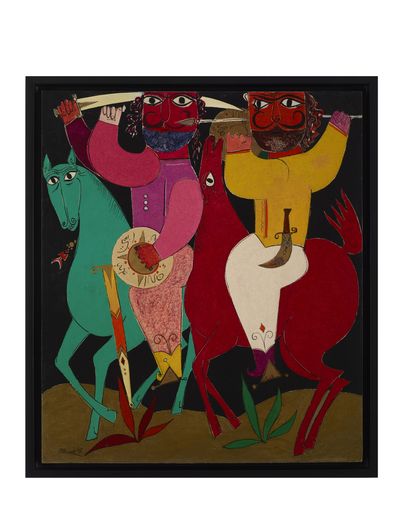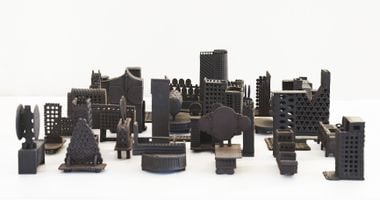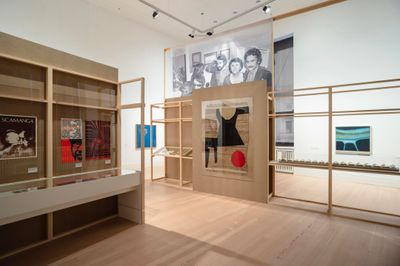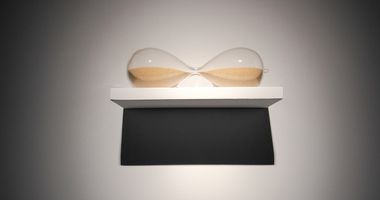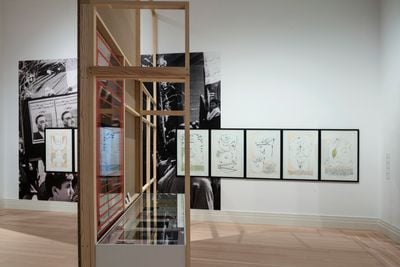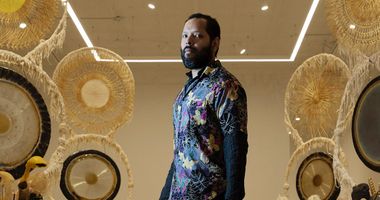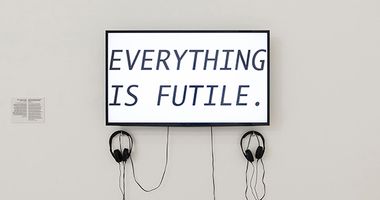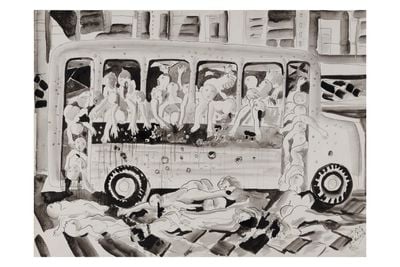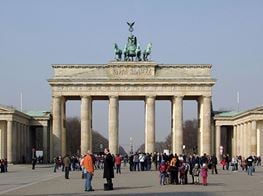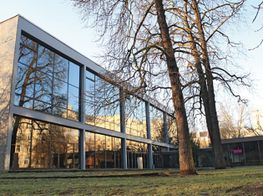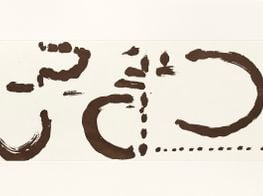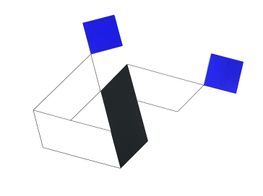Beyond Fragility: On Beirut’s Resilient Modernism
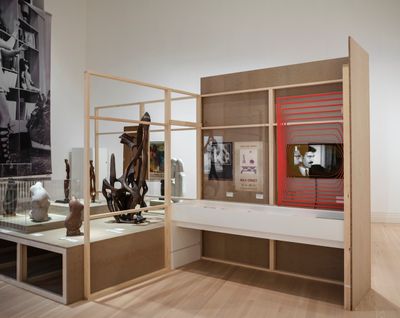
Exhibition view: 'The Body', Beirut and the Golden Sixties: A Manifesto of Fragility, Gropius Bau, Berlin (25 March–12 June 2022). © Luca Girardini. Courtesy Gropius Bau.
By the early 1970s, Beirut had become a destination for Baghdadis, thanks to its mild weather, safety, and inclusive cosmopolitanism. Through my research on Baghdad's 20th-century modernism, I interviewed many who frequented the Lebanese capital, which had become synonymous with a licentious modernity in an otherwise conservative region.
But while these artists and architects were familiar with Beirut as a vibrant city, they were barely aware of its art scene. Considering the art groups that emerged in Baghdad, and their curiosity about concurrent global developments, the lack of artistic exchange between Baghdadi and Beiruti artists has always been a mystery to me.
So it was with much anticipation that I visited the exhibition Beirut and the Golden Sixties: A Manifesto of Fragility, co-curated by Sam Bardaouil and Till Fellrath at Gropius Bau in Berlin (25 March–12 June 2022).
The show is organised chronologically and thematically, across a series of enfilade rooms. Archival images printed on large translucent fabrics, with occasional television clips, set the tone throughout.
The first section, entitled 'Le Port de Beyrouth: The Place', affirms Beirut's reputation as a city of leisure. Upon entering, viewers encounter an enlarged image of women and children frolicking in the Mediterranean alongside a small untitled 1958 painting by the self-taught Khalil Zgaib—an elementary depiction of Beirut's port congested with warships and soldiers, recalling the American military intervention that year.
A label explains the purpose of 'Operation Blue Bat' was to effectively replace President Camille Chamoun, despite the prosperity he brought to the country. The entire exhibition is bracketed between the 1958 invasion and the so-called Lebanese Civil War (1975–1990), making turmoil an ever-present spectre.
Another label underlines the vitality of the port to Beirut's economy and multiculturalism, and its recent destruction by the horrifying August 2020 explosion.
Spanning a multitude of representational methods, many works merge abstraction with figuration and engage familiar movements within Westernmodern art, including Impressionism, Fauvism, and Cubism.
In La Montagne Liban (1971), a painting by Etel Adnan and Simone Fattal, a mountain, sky, and sun are discernable, yet the surface is reminiscent of abstract-expressionist compositions, both in its rough, gestural brushstrokes and broad colour fields.
This is a momentous exhibition in scale and includes a wide range of material showcasing the richness of Beirut's post-World War II art scene. But the show also raises several questions.
Works are displayed on walls or nestled within informal wooden grid structures, seemingly designed to look cheap and unfinished. Mostly positioned diagonally, perhaps these structures are supposed to evoke the 'Fragility' from the exhibition title—a central concept left unexplained. Is Lebanon's modernism meant to be fragile? Beirut's art scene? Those decades? The city itself?
Following the emphasis on Beirut's shoreline, the next room presents images of hedonism in cabarets, casinos, and ski resorts, juxtaposed against squalor in refugee neighbourhoods, as captured in Paul Guiragossian's Armenian Camp (1960), a sombre oil on canvas of muted greens and ochres, evoking a nondescript, tightly packed quarter.
Intimacy and portraiture are the subjects of the next section, 'Lovers: The Body', anchored by the surrealism of Huguette Caland's paintings and Dorothy Salhab Kazemi's glazed stoneware sculptures, both inspired by sexual organs.
The artists not only discuss what might have been taboo subjects at the time, but take charge of the body and its place in society. An early black-and-white video by Fattal, Autoportrait (1971–2012), is an intimate self-portrait; the artist reflects on memories, and the work speaks to the adoption of new and experimental mediums.
Formal explorations follow in the section 'Takween (Composition): The Form', featuring radically different studies by several artists. Among them, Saloua Raouda Choucair's extraordinary wooden sculptures abstract stanzas from Arabic poetry into interlocking kits that can be reconfigured into new shapes, and thus other meanings.
A label briefly mentions the debates that followed the 1943 end of the French mandate, giving rise to works that probed Lebanese modern identity. Remarkable paintings by Rafic Charaf, such as Untitled (1971), depict the fabled pre-Islamic Arab poet and warrior Antar, replete with motifs from regional heritage, and a flat representational method that conjures mediaeval illuminated manuscripts.
Centring politics more explicitly, the next section, 'Monster and Child: The Politics', revolves around the impact of local and regional strife on artistic production in Beirut.
From the fall of Egypt's Gamal Abdel Nasser in 1970 (captured in a monumental oil on canvas by Guiragossian produced that year) to the Palestinian cause, and from sectarianism to local strikes, the implication is a simmering pot that exploded into the 1975 Civil War.
The last section, 'Blood of the Phoenix: The War', focuses on art created during the early years of the civil conflict. Works by Aref El Rayess constitute the climax here, with two powerful series, etchings of drawings from 'The Road to Peace' (1973–1976) and a painting from 'Technologies of War' (1978), denoting the tragedies unleashed by that catastrophic episode in Lebanese history.
Again, a label reminds viewers of the relevance of these works to Beirut after the 2020 explosion.
Spread across the sections of this exhibition are vitrines with archival documents—including an impressive and informative collection of posters—providing a glimpse into artistic activities during those decades.
These include exhibitions organised by Gallery One, Beirut's first permanent commercial art space, established in 1963 by artist Helen Khal (whose work is also in the Berlin exhibition) and her husband, poet Yusuf al-Khal.
This is a momentous exhibition in scale and includes a wide range of material showcasing the richness of Beirut's post-World War II art scene. But the show also raises several questions.
Its design is peculiar, with its rickety and impoverished quality, suggesting that Beirut's modernism was not only 'fragile', but makeshift and ephemeral—a perplexing choice, considering Beirut, at least the city of the middle and upper-middle classes to which most of the artists in this show belonged, is one of the finest urban centres in the region.
Besides the danger of perpetuating damaging stereotypes, the design compromises the works on view, already difficult to read due to the haphazard groupings—some of which attempt to characterise the city, while others propose formal attributes that presumably unify some of the work produced in Beirut.
One gets the impression that the curators aimed to convey the presence of more collective concerns than actually existed—but ironically, the works grouped under their categories imply that while there were many fascinating individual experiments, there were hardly any joint projects (which explains why Baghdadis were mostly unaware of Beirut's art scene, aside from the work of a few individuals).
This is underscored by the inclusion of works by regional artists like the Egyptian Mahmoud Saïd, Syrian Fateh al-Moudarres, and Iraqis Dia al-Azzawi, Hashim Samarchi, and Mehdi Moutashar. Some are introduced because they depicted Beirut, others because their works seem to bolster the collective tendencies the exhibition claims.
Regrettably, historians of non-Western modernisms are still often told the art we study is a derivative of the Western canon.
Between these Arab artists and the Lebanese who lived elsewhere, the show curiously does not dwell on whether the works on display were produced in or shaped by Beirut. Moreover, the exhibition is so concerned with reminding viewers about political turbulence—almost fetishising the experience of war—that it misses the opportunity to make sense of or develop an appreciation for the art itself.
Regrettably, historians of non-Western modernisms are still often told the art we study is inferior aesthetically and technically, a derivative of the Western canon. This places a serious responsibility on our shoulders to not only make 'other' modernisms visible but expand on why they took distinctive forms, employed certain mediums, and how they were morphed by specific landscapes and cultures.
Furthermore, while the exhibition is structured around the hypothesis that animosities festered beneath the surface of the 'Golden Sixties', or the years leading to the Civil War, this idea is difficult to legitimate through the art itself—much of which appears politically indifferent, thus undermining the show's premise.
Given the exhibition's focus on explaining context, there could have been more acknowledgement of the lasting impact of the country's French colonial past and a more rigorous examination of foreign political interventions and military incursions.
Additionally: why is there such a conspicuous absence of Beirut's Muslim communities, essential to the city's diversity and complexity? Where are the traditional works in calligraphy, and other popular or 'folkloric' art genres? And why should Beirut's modernism fit Western definitions?
These questions aside, the least compelling part of this exhibition is its incessant desire to view Beirut's modernism through a lens coloured, even clouded, by an amplification of the city's past conflicts and present crises.
Take the inclusion of a newly commissioned installation by Joana Hadjithomas and Khalil Joreige, As night comes when day is gone (2022), which encircles viewers with 12 synchronised screens and two projections displaying surveillance footage with scenes repeated on loop—endlessly replaying the exact moment the August 2020 blast hit the Sursock Museum in Beirut.
Disregarding the trauma these scenes could trigger, the terror they register overpowers the installation, not to mention the experience of the exhibition. The curators conclude their wall text by pondering the role of art in times of hardship. Their answer, it appears, is none: art is decimated by war.
The paradox here lies in how the historical material evades the curators' prescribed reading. What I took from this show is not how conflicts overwhelmed Beirut and its modernism. Rather, I was struck by how Beirut survived, even thrived, against all odds. Like Baghdad, a city that has had its share of tribulations, I see an undefeated Beirut and a resilient modernism. —[O]



